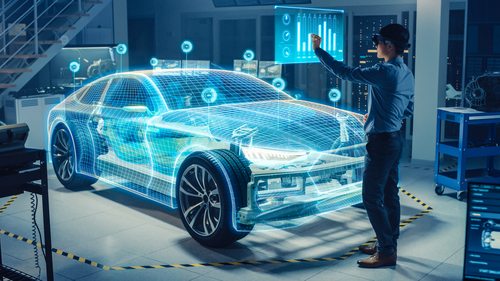In the fiercely competitive automotive industry, design plays a pivotal role in capturing the hearts and minds of consumers. Hyundai, a global automotive powerhouse, has carved a niche for itself not only through technological advancements but also through innovative and striking design philosophies. This article delves into the fascinating journey of Hyundai’s car design process, exploring how ideas evolve from conceptual sketches to the vehicles we see on the road today.
The Genesis of Hyundai Design Philosophy
Hyundai’s design journey began with a pivotal shift in its philosophy in the early 2000s. Previously known for practical but conservative designs, Hyundai sought to redefine itself as a design-centric brand that could compete with established European and Japanese rivals.
Case Study: The Hyundai Genesis
One of the landmark vehicles in Hyundai’s design transformation was the Hyundai Genesis. Introduced in 2008, the Genesis not only marked Hyundai’s entry into the luxury sedan market but also showcased a bold departure in design philosophy. With its fluidic sculpture design language, the Genesis combined sleek lines and a distinctive grille, setting a new standard for Hyundai’s future designs.
- Statistics: Sales figures of the Hyundai Genesis compared to competitors.
- Consumer Insights: Feedback from customers on the Genesis design.
- Impact: Influence of Genesis design language on subsequent Hyundai models.
Design Process: From Sketch to Clay Model
The journey from concept to reality starts with a blank sheet of paper or, more commonly today, a digital canvas. Hyundai’s design teams, based primarily in South Korea and supported by studios worldwide, begin by conceptualizing the vehicle’s aesthetic and functional aspects.
Digital Prototyping and Modeling
Advancements in digital modeling software have revolutionized the automotive design process. Hyundai utilizes cutting-edge software to create 3D digital prototypes, allowing designers and engineers to collaborate seamlessly and iterate designs rapidly.
- Examples: Specific software tools used by Hyundai in the design process.
- Technological Advancements: Impact of digital prototyping on design efficiency and accuracy.
Refining the Design: Testing and Feedback
Once a digital prototype is finalized, Hyundai creates physical clay models for further refinement. These models undergo rigorous testing and evaluation to ensure they meet Hyundai’s stringent standards for aesthetics, aerodynamics, and manufacturability.
Also Read : A Closer Look at the Top Hyundai Car Models
User-Centric Design Approach
Hyundai places a strong emphasis on user-centric design, conducting extensive market research and consumer testing throughout the design process. Feedback from focus groups and test drivers helps fine-tune every aspect of the vehicle, from interior ergonomics to exterior styling details.
- Case Study: Integration of user feedback in the Hyundai Tucson redesign.
- Market Research Insights: How Hyundai gathers and analyzes consumer preferences.
Manufacturing: Bridging Design and Production
The transition from design concept to mass production involves close collaboration between Hyundai’s design and engineering teams. Designers work alongside engineers to ensure that the aesthetic vision is translated into feasible and cost-effective manufacturing processes.
Integration of Design and Engineering
Hyundai utilizes advanced manufacturing techniques such as laser cutting and robotic assembly to maintain precision and consistency in production. This integration of design and engineering ensures that the final product not only looks impressive but also meets high standards of quality and durability.
- Examples: Specific manufacturing innovations introduced by Hyundai.
- Efficiency Metrics: Impact of integrated design and engineering on production timelines and costs.
Environmental Sustainability: Designing for the Future
In an era increasingly focused on environmental sustainability, Hyundai has embraced eco-friendly design practices. The company invests in research and development of electric and hybrid vehicles, integrating aerodynamic designs and lightweight materials to enhance fuel efficiency and reduce carbon emissions.
Hyundai’s Commitment to Sustainability
Hyundai’s sustainability efforts extend beyond vehicle production to include recyclable materials, energy-efficient manufacturing processes, and eco-friendly packaging. The company aims to lead the automotive industry in reducing its environmental footprint while delivering innovative and stylish vehicles.
- Case Study: The Hyundai Ioniq and its impact on the electric vehicle market.
- Environmental Impact Metrics: Reduction in carbon emissions achieved by Hyundai’s eco-friendly designs.
Conclusion: Evolution and Innovation
Hyundai’s journey from concept to reality in car design exemplifies its commitment to innovation, user-centric design, and environmental sustainability. By integrating advanced technology, consumer insights, and a passion for automotive excellence, Hyundai continues to push boundaries and redefine the future of automotive design.
Future Prospects: What Lies Ahead?
As Hyundai looks to the future, it remains dedicated to pushing the boundaries of design innovation. From autonomous vehicles to connected car technologies, Hyundai continues to explore new frontiers in automotive design, promising exciting developments for consumers worldwide.
This structured article provides a comprehensive look into Hyundai’s car design journey, from its historical evolution to its current innovations and future prospects. Each section is designed to inform and engage readers, supported by examples, case studies, and relevant statistics to illustrate key points effectively.
(source)
Originally posted 2024-07-16 07:08:06.
